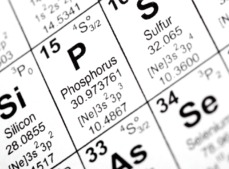Phosphorus (P)
 Phosphorus is one of the important major nutrients or "macronutrients", but is a double-edged sword. It has many roles in plant and root growth and the formation of DNA. It also utilises the sun's energy to convert CO2 + H2O to sugars and oxygen. There tends to be fairly large amounts of P in northern hemisphere soils, though much of it is insoluble and therefore only released slowly. This can cause excess P to be applied to the land.
Phosphorus is one of the important major nutrients or "macronutrients", but is a double-edged sword. It has many roles in plant and root growth and the formation of DNA. It also utilises the sun's energy to convert CO2 + H2O to sugars and oxygen. There tends to be fairly large amounts of P in northern hemisphere soils, though much of it is insoluble and therefore only released slowly. This can cause excess P to be applied to the land.
An excessive P level in soil is one reason why trace element availability has declined so rapidly since World War 2. Superphosphate, a commonly used fertiliser, contains a large quantity of sulphur (11.5%) and the excessive sulphur leaches through the soil taking with it the cations, potassium, magnesium, calcium, sodium and trace elements. Dairy farms import large quantities of feed containing P and this builds up in the soil over time to excessive levels. Excess P restricts plant uptake of the other essential nutrients and degrades the performance of both the pasture and the cow.
The lesson to be learned is that high soil indices of P do not represent "money in the bank", but are an expensive way to degrade the performance of any agricultural or horticultural enterprise.
